beneath the surface with jack macrae
The sun has set beneath the horizon — now we’re going beneath the surface.
Beneath The Surface is a new interview series that explores the less seen (and sometimes buried) side of creativity — the emotions, the ups and downs, the self-doubt, and, of course, the vulnerabilities.
//
It’s a crisp morning in Coolum and we’ve just dried off. It’s hard to get out of the water when the waves are this fun.
Jack’s still in his trunks and Tim’s already showing us his favourite shots from the morning — he’s been treading water for the last two hours with his underwater housing.
It’s time for a coffee, so Jack takes us to his favourite local. “Best coffee on the coast”, he reckons. So, here we are: egg and bacon roll in one hard, coffee in the other.
The coffees great and the company is better. These are moments to cherish.
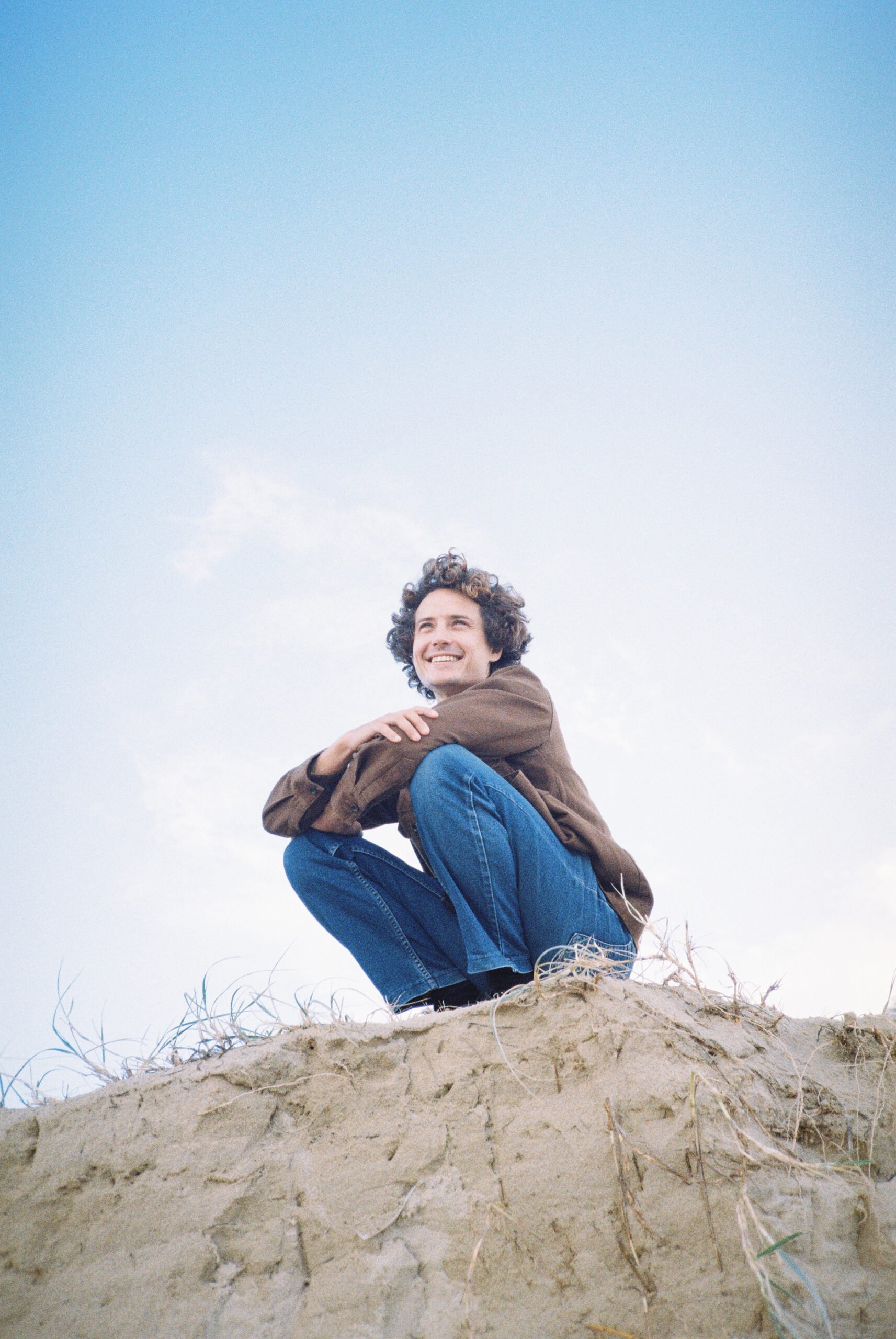
Are we on?
Tim Birch: Yep.
All right, Jack. What’s been happening lately?
Jack MacRae: So, lately I’ve just been working. Unfortunately, I haven’t had as much studio time as possible, but we’re back into it now and I’m pumped to be working on a bunch of new stuff and changing my style up a bit.
Want to tell everybody what we did this morning?
So, this morning, we went out at Coolum pocket for a couple of hours. I bodysurfed and the other boys surfed. Everyone was ripping. It was unbelievable. The banks are very good, so don’t come and check it out.
TB: It’s blown.
JM: It’s blown.
You’ve blown it.
My bad.
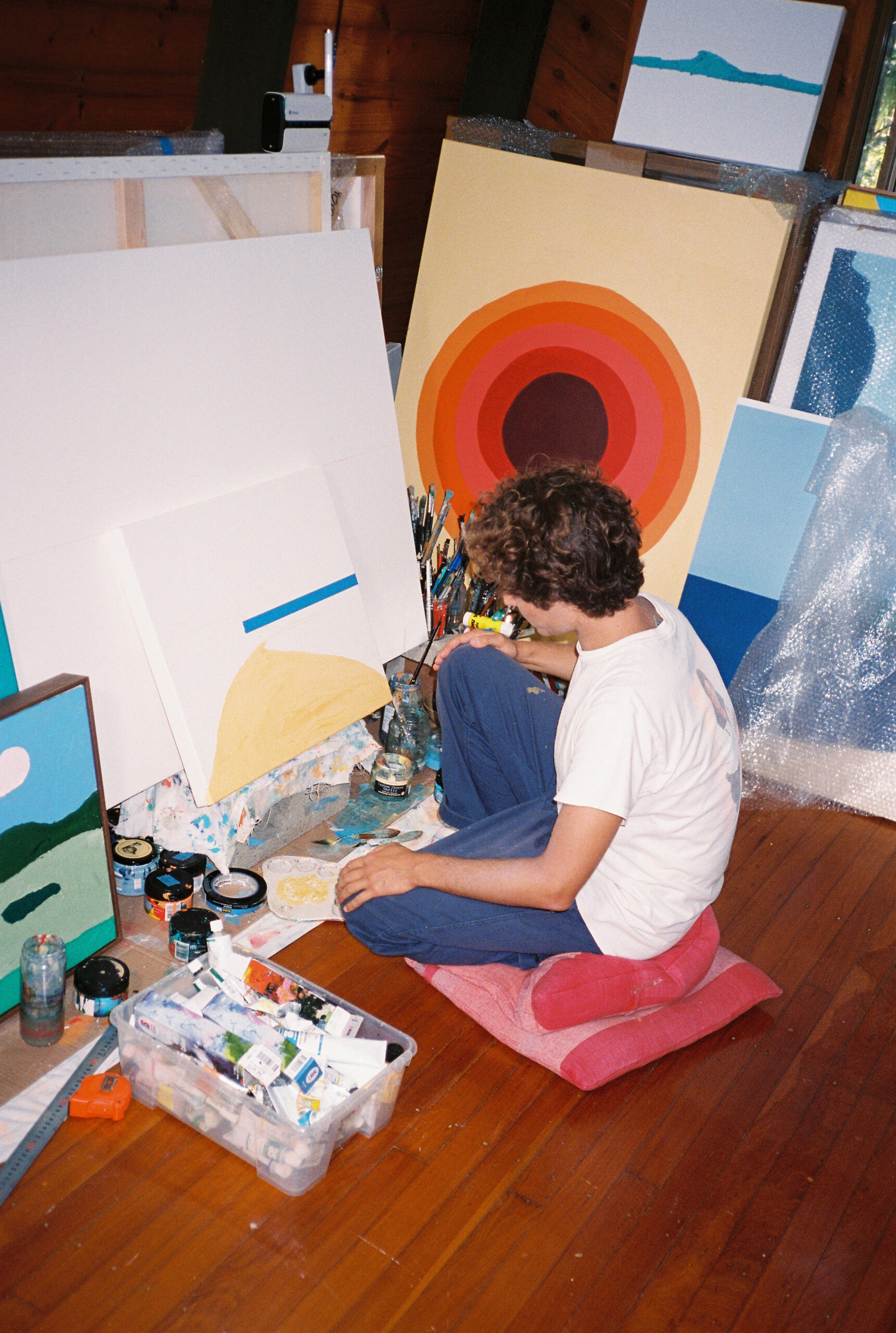
All right. Obviously, your close friends know you really well, but for the less lucky, who is Jack MacRae?
So, I live on the Sunshine Coast in Yaroomba. I’m a painter and a graduate of architecture — I’m training to get my registration. I absolutely love surfing and body surfing and painting.
Yeah, you do! Let’s strip it right back. Talk to us about your creative practice. What do you actually do?
I would say that I’m a hard-edge, color field, artist. I mainly specialise in landscape paintings. Originally, I started with collages, but unfortunately had to progress from there due to weather screwing with the paper. Now I mainly paint. It’s very formalist and paired back. I try to make it as simple and effective as possible.
And tell us about your other job. What do you do for work?
I work for a project management company and I’m their in-house designer — so, I’m their CAD guy. I’m the guy at their front-end, middle-end and back-end of a project when we start putting buildings up.
And your hobbies? how do you like to keep yourself busy outside of work?
Well, I keep myself pretty busy nine to five. When I get home, I either go for a bodysurf or just come straight back home to paint or and make art…
You like to get in the water every morning, don’t you?
Yeah, every morning I’ll try and get to the beach for a swim or a surf so I can start my day as best as possible. Then, after work, I need to decompress and release the stress — I’ll usually paint all night long and most of my weekends. I don’t really go out too much to let the world in. But I like that… That’s my version of fun.
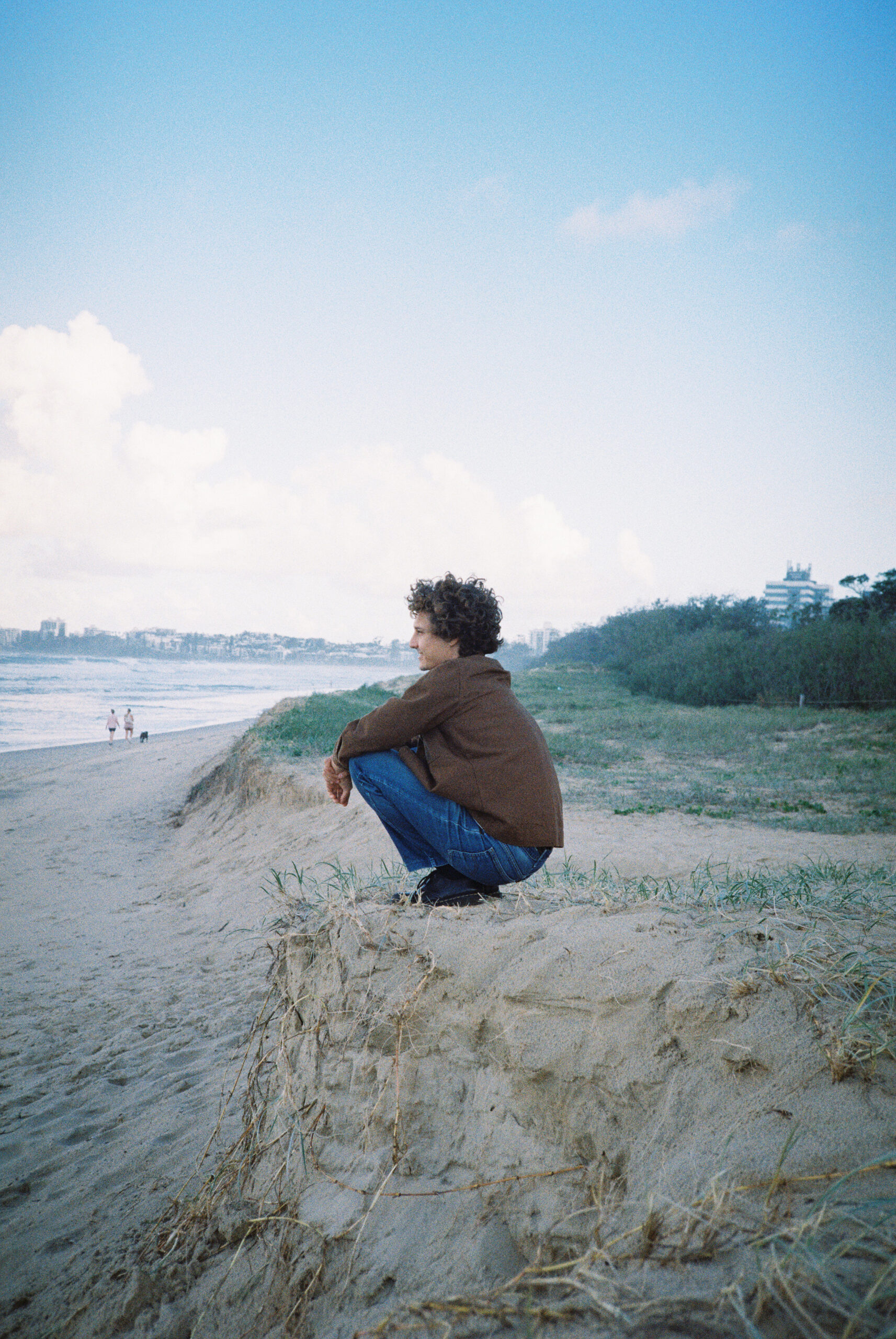
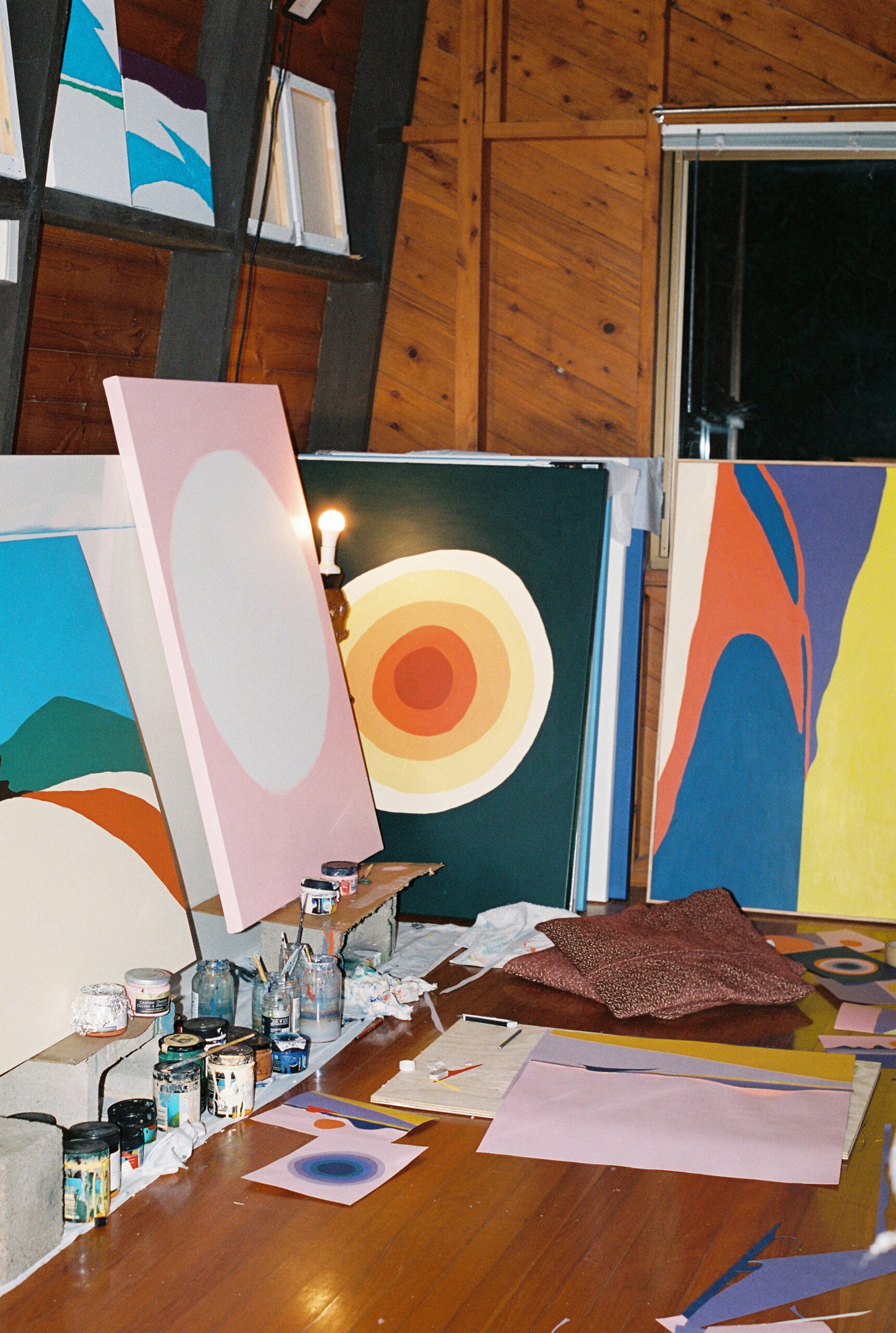
What is your favorite thing to do in the world?
Bodysurf… It’s the closest you can get to nature and it’s the most pure and simple form of surfing.
Have you always lived here?
No. So, I grew up in Brisbane. I lived in my family home for 20, or 21 years — my grandma lived with us, too. Then I moved to Fingal Head in the Northern Rivers, or Tweed Region, where I lived out the childhood that I wish I had lived — in a cul-de-sac, surfing every day, and getting rid of as much responsibility as I possibly could — before deciding that if I didn’t leave Fingal now, I was never going to leave. So, I got up and left and traveled as much as I could before having to go through COVID lockdowns.
Side note: what was your quiver in Fingal?
Oh, so there was a wedge at Dream Time on the backside and we just bodysurfed to that non-stop. The causeway had a pretty insane righthander and there was a few huge bombies down the road, so I would ride everything from a 5’2 fish right through to a 7’10 single fin. I would surf as much as I possibly could. The place was heaven. There was no one on the beaches during the middle of the week —it’s changed a lot now.
Are you sticking around the coast? There’s a heap of good creatives here at the moment — it would be a shame to lose you.
[Phone rings.]
Shit, that might have been my phone. I honestly have no idea… Yeah, I think I will end up sticking around at this point. The Sunshine Coast has always been so good to me. I’ve spent most of my childhood coming here on holidays and it’s been super exciting for my career and the progression of the Sunshine Coast is huge.
Let’s talk about the younger years. Were you a creative kid?
I wouldn’t say that I was the most creative kid. However, I did win the Grade One Art Prize. I definitely wasn’t the most studious, or applied, child to school in — other than sport…
Jock MacRae.
Hahah, yeah, I guess I was a bit of a jock… But no, my mum and my grandmother used to make all their own patterns and were always sewing at home. So, I’ve watched them for years, and years, and years, pattern making — making all our clothes. And that’s probably where the collaging came from in my own practice…
It’s funny because when we were surfing earlier, I asked if your folks were creative. You said “not really” but hearing that now, it sounds like they were…
Yeah, I guess so. Mum and nanny have taken over most of the downstairs area outside of dad’s PlayStation zone and they just talk Serbian and sew and knit all day long — it’s unreal.
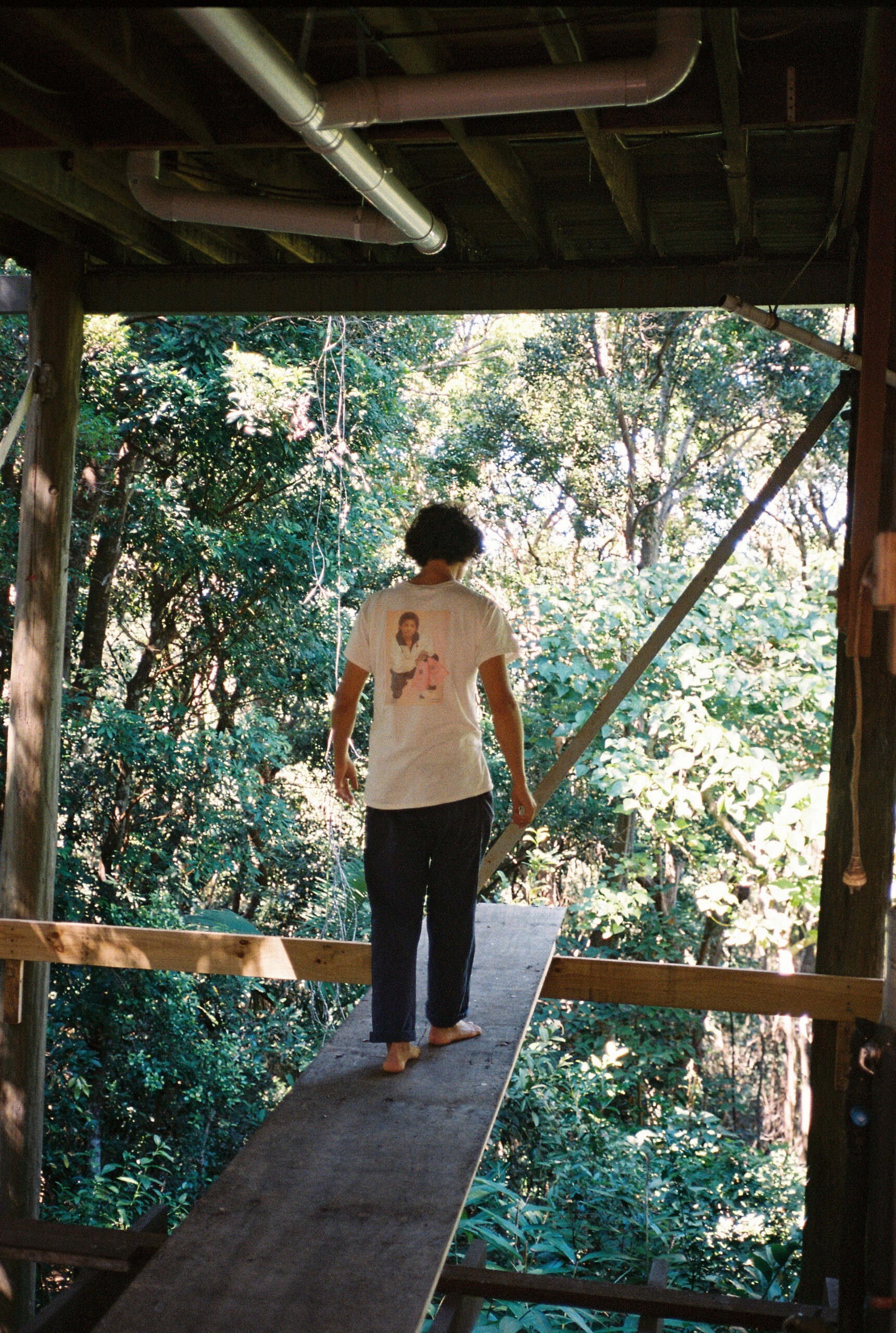
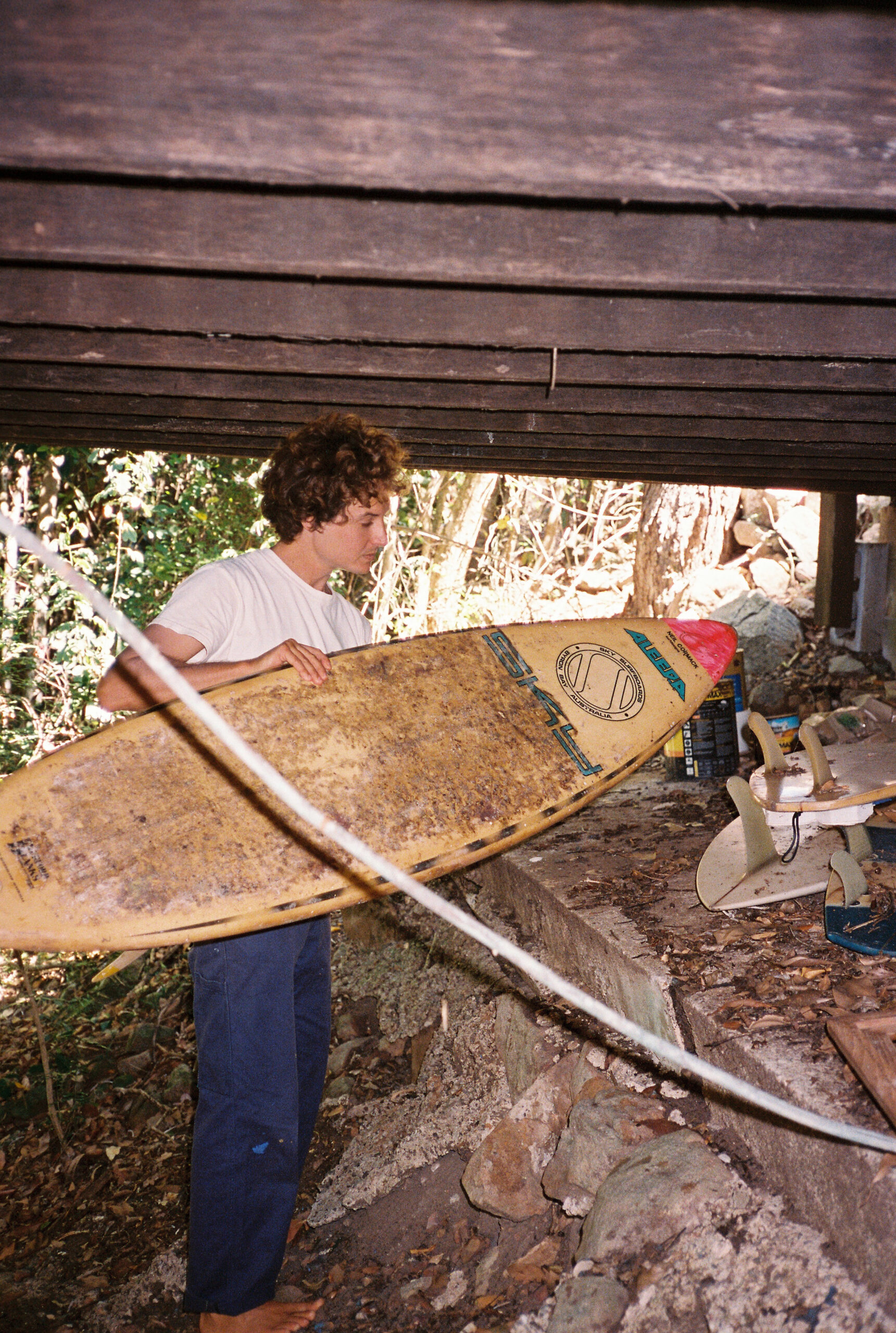
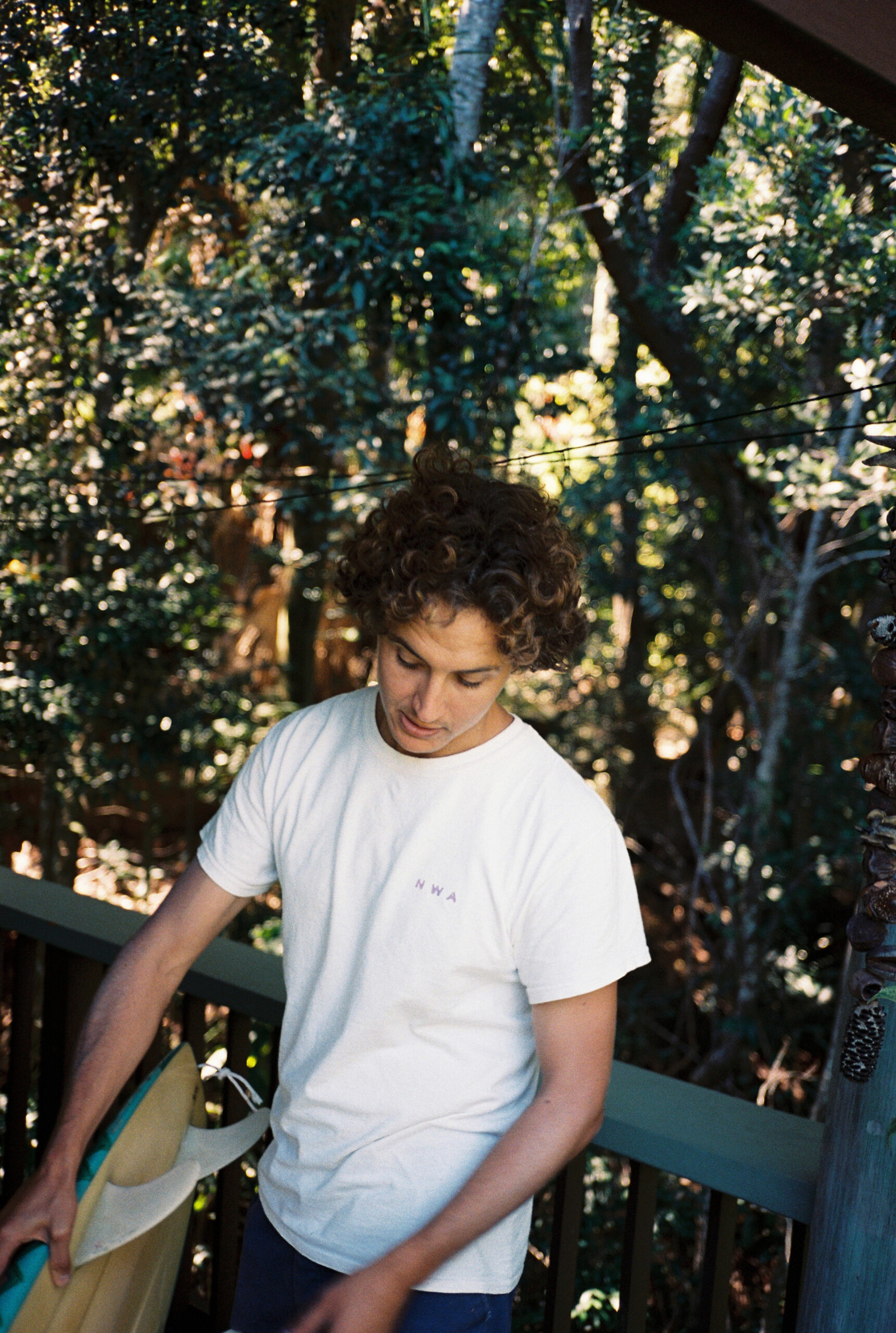
Your style is extremely unique. I haven’t seen anything that looks like your work, which is nice — it’s very Jack MacRae. How did you land on your style? And why the collages? Why these bold colors?
Jack MacRae: So, there’s probably a few different things that led to it. It’s a well thought out process but one day it just clicked. I’d worked for a lot of different architects who only believed in hand drawing, hand building, hand creating, because doing stuff on the computer, you get stuck in a version of Atari World — it’s not real and you lose a sense of scale. So, that sort of knowledge transferred through to my practice, where I had to hand create things. In my final years of architecture, we studied modernism architecture, and formalism, and the syntax of architecture. One day I just created a Wollumbin A5 collage that was four or five colours. It was a very simple. I hand cut it, glued it together, and just went, “Wow, this is super effective!”. I really liked it. I like to keep it as simple as possible and be able to recreate it over and over again, ensuring it’s all handmade and as special as possible. Everyone has a favorite landscape, and everyone has favorite colours, so everyone can respond to it.
Yeah, for sure. I’ve spoken to you about this in the past — about how whenever you have a spare minute, all you think about doing, and all you want to do, is just come up to this room and paint [we are sat in Jack’s upstairs studio]. Why do you feel the need to block yourself out from the outside world?
I think it’s just a case of trialing different things. I mean, at the end of the day, I might not be in the most creative job, but it might just be me wanting to create and try new things, new color palettes, different landscapes, test out new methods of painting and see what happens. And just being able to immerse myself in this space and sit there with this huge canvas in front of me — and go face to face with it — is something that I feel the need to do.
Your style is clearly you — and you’ve landed on it for whatever reasons — but do you ever find that you have to fight the urge to adopt new styles? Or are you open to your style evolving and one day somebody looking at your artwork and going, “Oh, I didn’t expect that to be Jack McRae?”.
I’m definitely open to evolving my art because at the end of the day, everything should evolve — change is always good. I definitely go through stages of trial and error. There are some things that might not work, but it’s just a case of sitting down and just trialing new things that I haven’t done before. It might not be techniques, but it could be the things that I want to paint — like doing a striped painting as opposed to a collage.
Do you see imitation as a form flattery or would it bother you if you started seeing your sort of stuff elsewhere?
I’m lucky that I haven’t seen much imitation at this stage, so I’m very happy with that. But I would also be highly flattered unless, again, someone was profiting and doing way better than I was [laughs]. But, at the end of the day, it could be two train of thoughts that have come from two different places to end up with the very similar results. So, you can’t get too annoyed. It’s a tough one.
Are you trying to tell the audience anything through your work? Is there a message that’s flowing through all your pieces? Or is it as simple as: ‘I reckon these landscapes are rad and I love the colors?’.
I think it’s as simple as that. I don’t really have a message for people. Generally, my pieces are quite happy. There’s not much doom and gloom and hopefully what I paint can bring happiness and joy to others.
I love that. Your artworks are you in canvas form.
Yeah, well hopefully. I guess it’s painting that makes me happy or doing the art that makes me happy. So, hopefully that comes through.
Let’s chat about your full-time job. You work as a draftsperson — was that always something you wanted to do?
I was very fortunate as I was always able to say, “I think I want to do architecture.” I’ve always been in love with this Geoffrey Pie house in Peregian — my cousin’s one. And there’s a few other Geoffrey Pie houses in Peregian, which are just like, phenomenal! They don’t age, or, if they do, they age with character. They’re extremely vernacular, well-built houses. At 15-years old I thought, “I want to create houses like that”. And then all of a sudden, I ended up going down this really long path of architecture. I absolutely love it. I think architecture paves the way for the rest of the world.
Your architecture practice seems so methodical — everything seems so straight and thought-out. Yet your creative practice seems like the polar opposite — It’s so malleable, it’s free flowing, it seems like the total opposite. Is your artwork the balancing point in your life?
I don’t see the work that I’m currently doing as massively a creative outlet. There are definitely elements where it feels creative. However, at the same time, my architecture does flow through to my art with the hard edges, and the hard lines, and certain methodical parts to it.
And what’s the hardest thing about juggling your creative practice and a full-time job?
They’re both pretty much full-time jobs. One of them is paid quite consistently and the other one ebbs and flows. And if you can get both working at the exact same time, it’s fantastic.
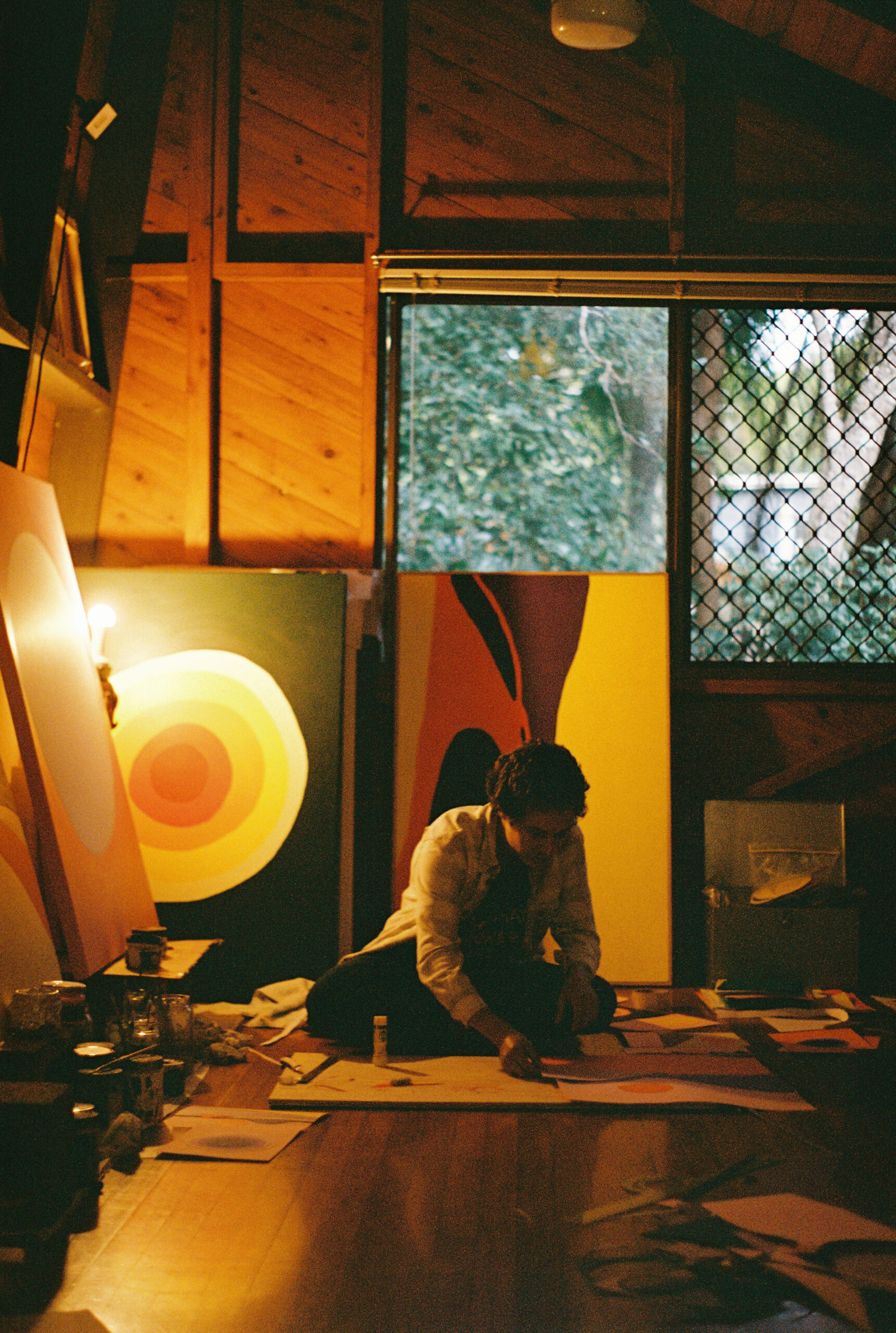
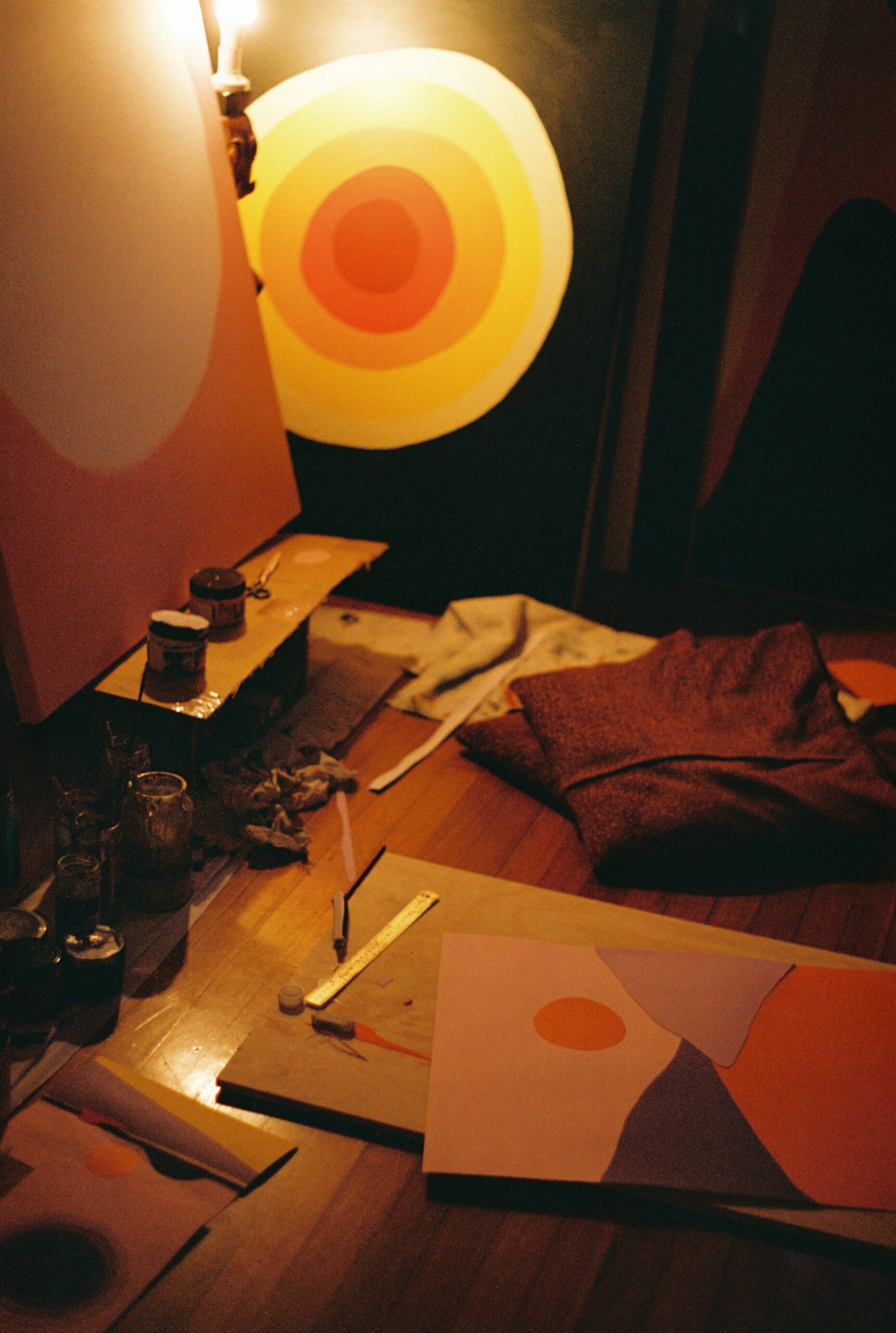
Would you consider that an important factor in your own overall happiness?
Yeah, absolutely. If I can have somewhere to go and explore, be outdoors, go to the beach, that drives me to work creatively. Living at Fingal, I would go and watch the sunset at Chinderah, over the Tweed River, and just watch Mount Wollumbin most afternoons. And it’s such a similar feeling with Mount Coolum as well. For some weird reason, giant rocks with giant mountains just give me a sense of feeling like home, which is awesome.
And is that why most of your pieces reflect these landscapes?
Yeah, it just feels like home to me. They always change colours, have different sunsets, different moods, different days.
I see. I want to talk about bodysurfing. How did you land on that? It’s quite bizarre how good you are.
Yeah, so bodysurfing is hopefully my next career path [laughs]. I’ve always bodysurfed as a kid. Dad would say, “Go out and go for a swim!” or we’d just throw ourselves into shore breaks on days that we couldn’t surf. And when it was too big, we’d just go out and swim.
Unreal.
When I moved to Fingal, there was this epic little wedge and my good friend Rory and I decided one year when we first lived there, “Hey, let’s have a bodysurfing competition. 10 bucks entry, whoever wants to be involved, winner takes all.” Rory smashed it the first year and the second year. And then, in our third year, we had our Wollumbin Womp Comp. We’d been partying for two or three days beforehand because it was like a bit of an Easter joke. Anyway, this one year, we get a phone call and there’s people down there waiting to watch! It’s like seven in the morning, we’re all hungover, and we’re like, “What the hell is going on!?”. The surf was pumping — like four foot out the back — and the current world champion was down there! [laughs]
Hahaha. Who was he?
His name is Tom Marr. His whole family were there. They had set up marquees, and we were just like, “Oh my God, we are so under prepared for this competition.” We were the one of the evolving bodysurfing competitions of the time.
That is gold. How’d you go that year?
I ended up winning that year, which is crazy. I beat the world champion — it was a sick joke. And then, the next year, the same thing happened. Someone decided to launch the Australian Team Championship and our little group of Fingal friends went down and we won! We were the first Australian champs.
Mental. And then what happened?
I packed up and moved away from Fingal.
And you moved here up this way?
Before I moved here, I was traveling. My first stop was Bali and the Deus Nine Foot and Single was on. It was easily 10-foot at the Canggu River Mouth. The water was filthy.
That’s a heavy wave, too.
Yeah, it was unbelievable. I ended up taking out the event.
Hahah, no way! Did you fly over for it?
No, I was just there. I was traveling the world and I didn’t take any surfboards with me — I just took my flippers. It was super easy.
I hear you’re going to Hawaii this year?
Hahah, yeah. I’m going over for the bodysurfing world champs. I’ve got a fair bit of training to do.
Ok, this is quickly become a Tracks feature. Let’s chat about some of the deeper stuff. When I look at you, you seem like this handsome, happy dude. Is there anything beneath the surface that you struggle with?
Um, it’s fair bit of what you see is what you get.
Shit, I wish I was in your head.
Haha, no, no. Everyone goes through their days, I suppose. And I guess working the nine to five grind is a bit of a stress and a struggle at times.
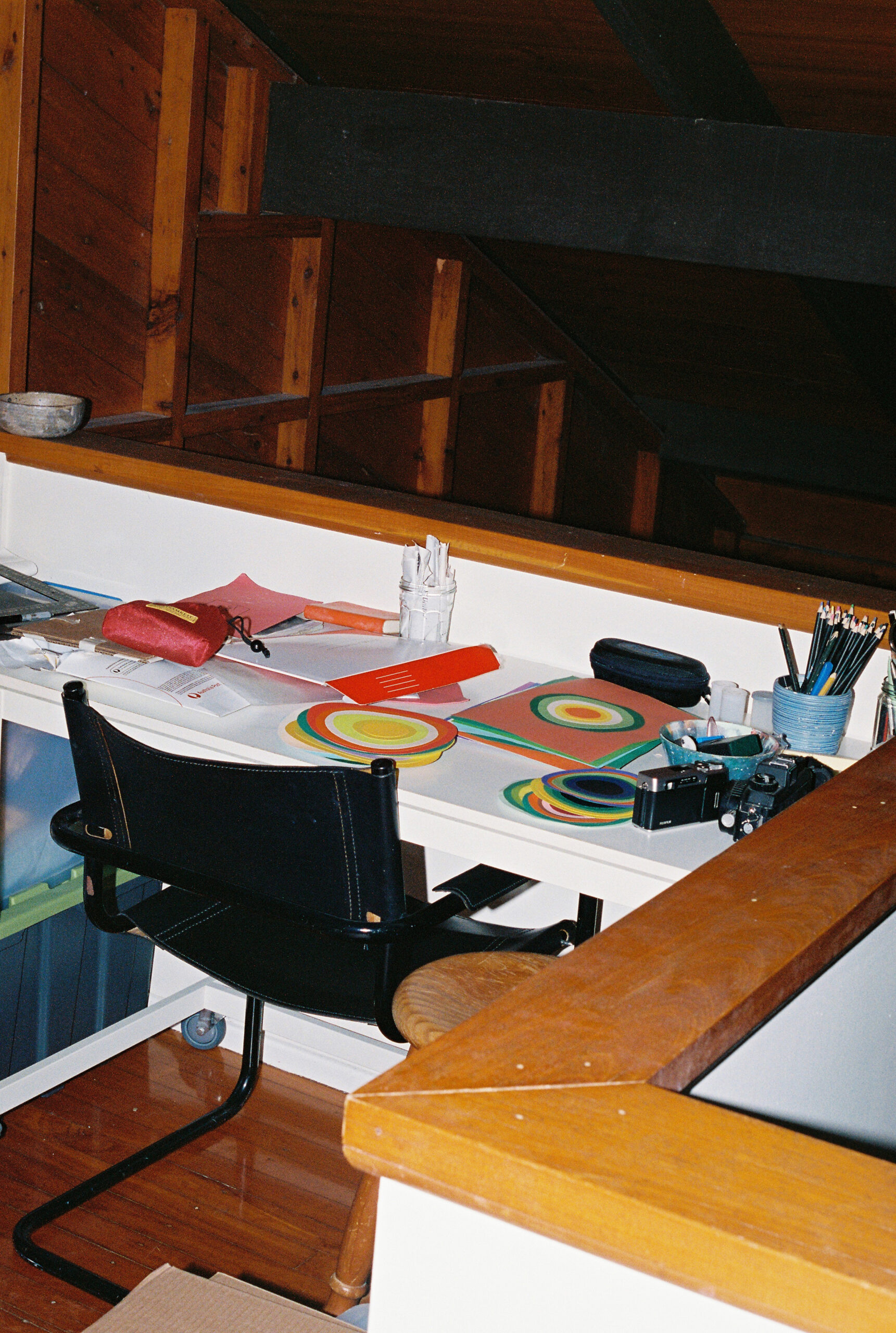
You’re an emerging artist and you’ve built a pretty solid name for yourself now. Is self-doubt ever something that creeps into your creative practice?
Definitely, there’s times of self-doubt. That’s for sure.
When does that usually happen?
Sometimes you just don’t feel like you’re progressing. You can get stuck doing submissions. Or commission after commission. You feel like you want to progress but you’re just not progressing at a rate quick enough.
Yeah. I feel like there’s probably a lot of creatives that feel that same feeling. It must be hard to stay motivated.
Yeah, it is. We live in such a digitised world of Instagram. It could be someone you know, or someone you don’t know, and they just become an overnight sensation. But it could be a fallacy. They might just be showing you the best bits through their stories. So, it’s pretty hard and interesting like that. You don’t know what’s real and what’s not.
Yeah, for sure. It sounds like your creative practice us very much an outlet. Something that keeps you sane during challenging times. Does that help you push through those moments?
Yeah, definitely. It’s like yoga for the mind. It’s an outlet for everything else.
Would you pack-in architecture if you could?
No.
You need it?
Yeah, I love it just as much as I love painting, granted, it’s a hundred times more stressful at the end of the day, and I’ll end up going grey from it. But, I feel like architecture has the chance to change the world. It should be the polar north of society and the way that the world moves forward.
Yeah, and it seems like influences your creative practice — especially seeing your sketches over there. It looks like you tackle your paintings quite methodically.
Yeah, absolutely. I know how to get it from A to B as good as I possibly can, with the least amount of resistance, in the simplest way. It’s the same with architecture. Someone needs to be able to build what you’ve drawn at the end of the day.
This is something like I sometimes think about. As I’ve got older, I sometimes wonder how much I’ve changed as a person, over the years. Like, deep down. Do you think you’ve changed? Or are you still the same person you’ve always been?
Jack MacRae: Definitely. I’ve changed for sure.
How so?
This is a place for me to come and reflect at the end of every day, or if something is on my mind, or if something’s happening, or if something doesn’t go my way. At the end of it all, I’m able to sit down, and reflect, and go through the motions.
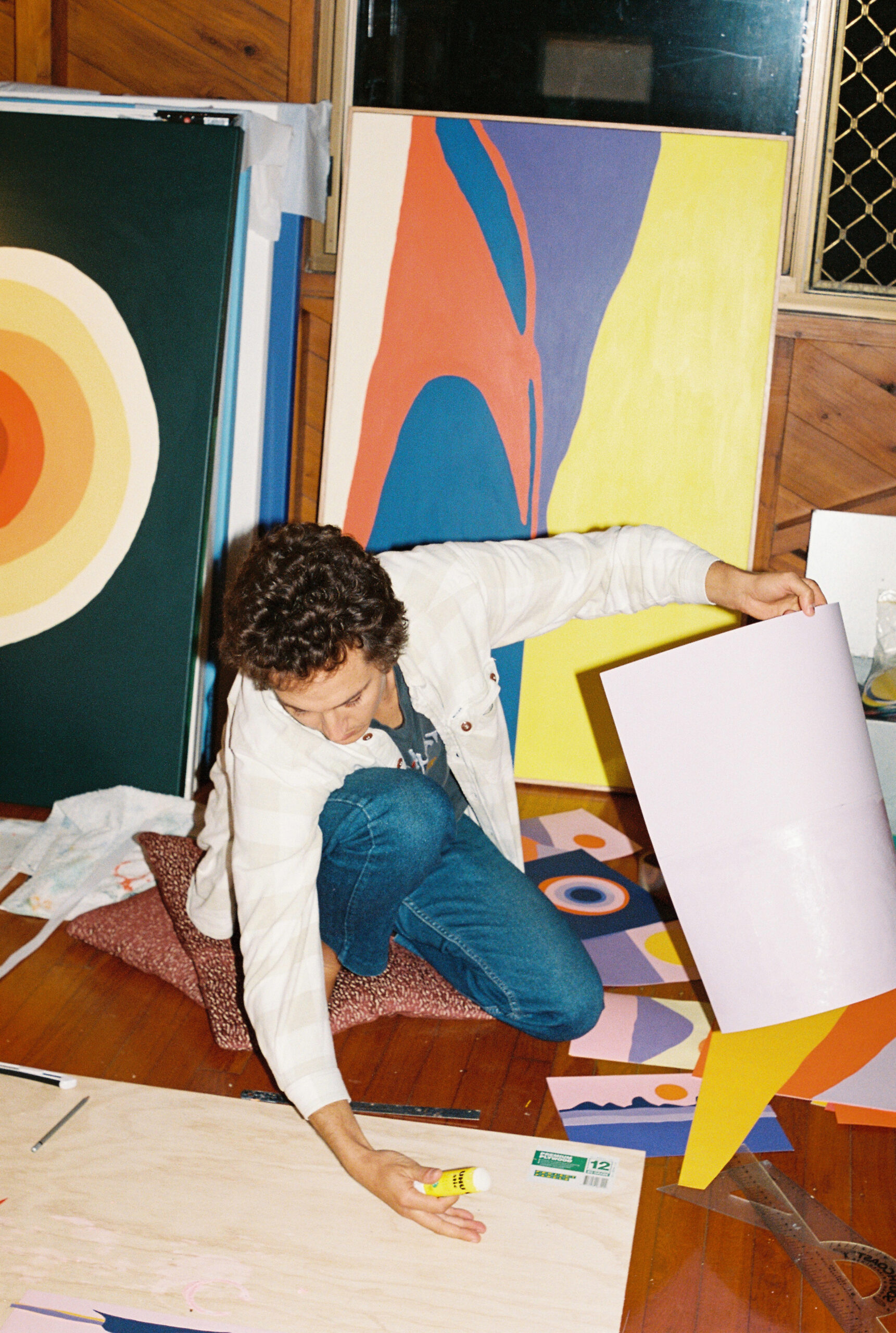
I feel like that’s a really positive thing that a lot of people probably don’t do…
Yeah, instead of me just having a quick reaction, I’m able to sit there and just take it all in… And understand it. I can then come up with a greater solution without having to be quick to respond.
There’s an art to that. Do you ever think about where you’re going next?
Yeah, big time. There’s always so many things that I want to do, and probably not enough time. But, I’ve definitely got an end, not necessarily an end goal, but a goal where I want to get to with architecture.
Is that in terms of your style?
Not necessarily the style, but the way that a building works and should work for you. And the way that the current building industry is in a state of environmental vandalism. It’s pretty disgusting. There’s got to be a better way to do things.
Do you reckon that’s achievable?
Those goals are the starting point to everything else. Everything else should start, in my opinion, falling into place. With the art, I honestly have no idea where that is going. Or what that goal is.
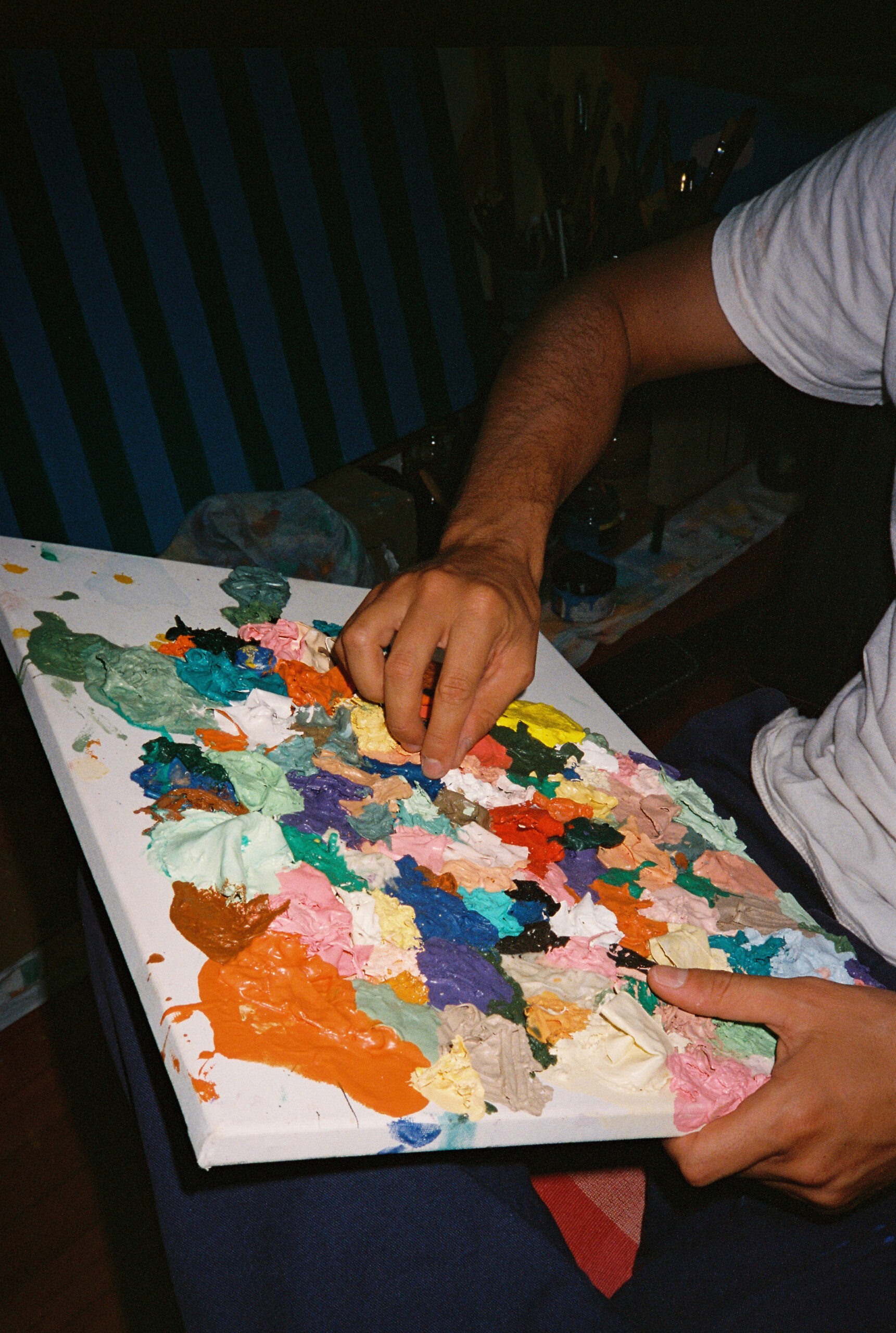
I’m seeing a common theme. Your work feels very structured. You have work goals. But your creative practice is free flowing. There are no goals.
Yeah, I just want to paint bigger, paint more, travel the world, do more shows, and see where that goes. If you asked me four years ago, “What will you be doing?”, I wouldn’t have said, here as an artist today. This is all completely new to me, and it’s moving pretty quick, and I like it a lot.
Are there any other things you do to calm your mind and to stay focused? Do you meditate? Do you do yoga?
A bit of Pilates and, like I said, body surfing or skipping lately. I love skipping.
Do you want to study art?
Oh, I’d love to study art and actually learn how to do fine art because right now right now my style is different and unorthodox, and I probably haven’t learned to paint correctly.
Yeah, but I love the fact that you’re self-taught. If you weren’t self-taught, your artwork would probably be heaps different.
Yeah. Well, I often flip through vintage Australian landscape painting books and think, “Wow, the people who could actually paint landscapes are incredible.” The stuff they do is amazing.
What do you do to pull yourself out of creative ruts? Maybe not ruts — but those periods where it just doesn’t seem to be flowing?
Because my work is so structured, I don’t go through too many creative blocks. My practice is quite simple. It’s as simple as coloring in a shape, or a different block, and you have a rainbow of colors to choose from. But, if I’m not feeling it, it’s a case of needing to go to an art gallery to get inspired. Or I need to go camping, or hiking, or disappear into the bush for a few days, or travel to be able to come back and go, “I’m so keen to get back into it”.
On your journey, as an emerging artist, what are some of the challenges you’ve faced when trying to create a name for yourself? What are the things, looking back, that’s been hard?
This is a good question. I’ve been very fortunate in the way that it has progressed so quickly for me. The support that I’ve had has been amazing. I’ve had friends who’ve given me art shows along the way and wanted to do galleries and all that sort of thing. So, I’m just wanting to do everything I possibly can in as short amount of time as possible. The opportunities that have come my way have been spectacular and I’ll always say yes to a good opportunity.
What are some things you’re proud of?
Good question. I’m definitely proud of where my art is at, that’s for sure. I love making paintings for people. That’s a really tough question. You’ve cornered me.
That’s good.
Yeah.
It’s nice that you feel that way.
Yeah, I guess. I’m definitely proud of the output of work that I have. I’m super proud that I’m self-funded. I’ve self-funded everything that I do. I go to work to buy my canvases, and to buy my paints, which is awesome, you know?
For sure. And I feel like, from the outside, that’s the most genuine part — your work is super authentic. The colors, the shapes, everything embodies you as a person. I think that almost is the nicest thing in all of this.
Yep.
Are there any failures? Or do you just not see failures as failures?
I’ve definitely had a fair few failures, over the last year. In just doing commissions and trying to rush things. Not looking at emails correctly or painting stuff around the wrong way or misdoing a shape or a color. This year, I’m trying to slow things down.
Artistic commissions are tricky, hey. There’s always a brief.
Yeah. But, I’ve got to be happy with the work that I put out there. And if I see something that’s wrong and it goes to that person — I can’t not see it. My paintings are not perfect. Some of the lines aren’t perfect. Some of the colors aren’t perfect. But some of those imperfections make the perfections at the end of the day. I’ve never done a perfect painting, and I don’t think I ever will. And that’s all good.
So, what’s plans for the year?
Well, Horizon Festival is next, and I’ve got a lot of different and new art that I want to show. A lot more compositional works. I’m working with Studio 26, which is really cool — it’s close to formalism art. So, hopefully that’s a new little path that I can go down and test out some new ideas.and, again, expand and grow my practice and different art theories.
Let’s assume that you are going to disappear tomorrow. You’re off surfing and painting for eternity. How would you want people to remember you.
Zoe, how do you want me to be remembered?
Are we still rolling?
Zoe: For your hair.
JR: I’ll leave a lock of hair for everyone.
Please.
Zoe: Or a curl.
JR: Yeah, a curl. A golden curl.

